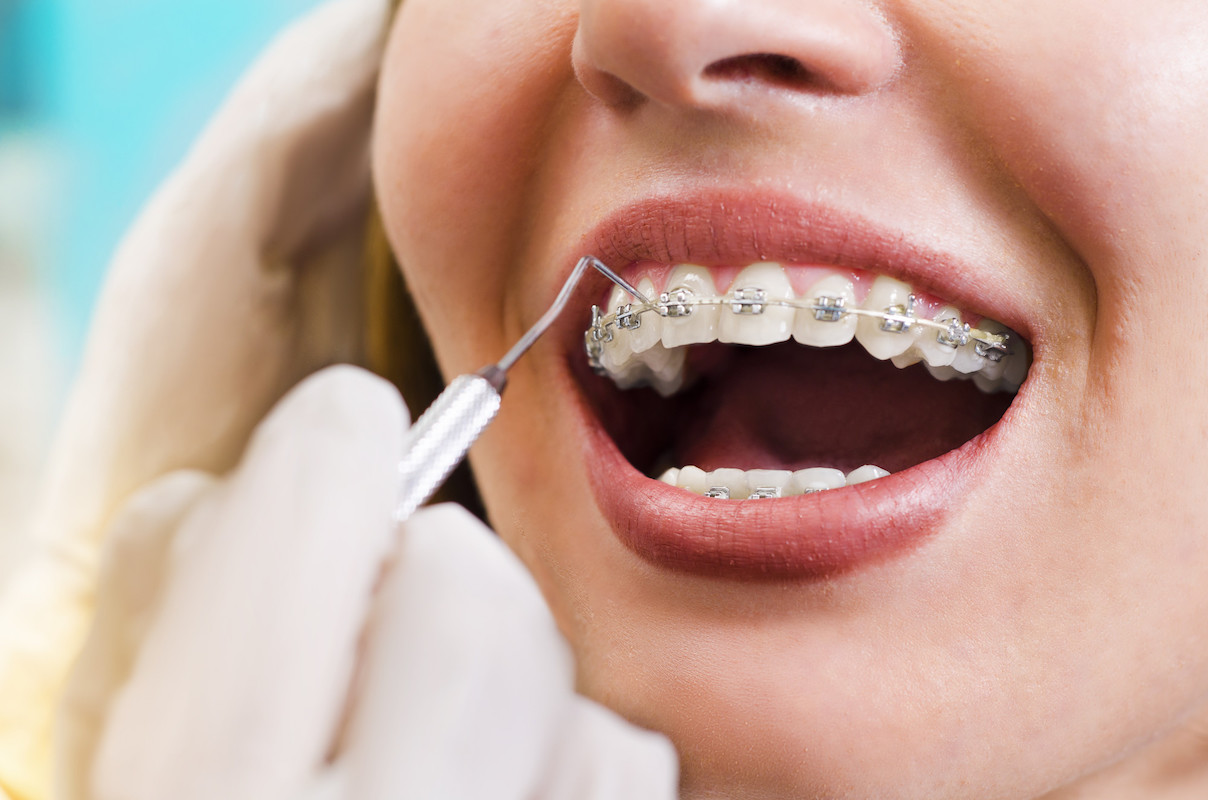Teeth braces are a common orthodontic treatment used to correct misaligned teeth and achieve a straighter smile. This article will provide an in-depth look at braces, including the procedure details, benefits, risks, recovery, and maintenance. We will also address common questions and compare braces to other orthodontic options.
Perfect teeth braces
Los aparatos dentales son una solución comúnmente utilizada para corregir problemas de alineación dental y lograr una sonrisa perfecta. Estos dispositivos consisten en brackets metálicos o cerámicos que se adhieren a los dientes, y alambres y bandas que los conectan. A medida que el tratamiento avanza, los brackets y los alambres se ajustan gradualmente para mover los dientes a su posición deseada.
Una de las ventajas de los aparatos dentales es su capacidad para corregir una amplia gama de problemas dentales, como dientes torcidos, espacios entre los dientes y mordida incorrecta. Además, los avances en la tecnología han llevado al desarrollo de aparatos más discretos, como los brackets de cerámica o los alineadores transparentes.
El uso de aparatos dentales requiere un compromiso a largo plazo, ya que el tratamiento puede durar de varios meses a varios años. Durante este tiempo, es importante seguir las instrucciones del ortodoncista y asistir a las citas de seguimiento regularmente para asegurar el progreso adecuado.
A pesar de que los aparatos dentales pueden causar cierta incomodidad inicial, como sensibilidad y molestias en la boca, los resultados finales valen la pena. Una vez que se retiran los aparatos, se pueden apreciar los dientes perfectamente alineados y una sonrisa radiante que mejora la apariencia y la confianza de una persona.
What are Braces?
Braces are dental appliances that consist of brackets, wires, and bands. They work by applying gentle pressure to the teeth, gradually moving them into their desired positions. Braces can correct various dental issues, including overcrowding, gaps, overbites, underbites, and crossbites.
Procedure Details
The process of getting braces typically involves several steps. First, your dentist or orthodontist will conduct a thorough examination of your teeth and jaw. They may take X-rays, photographs, and impressions of your teeth to create a treatment plan.
Next, the braces will be applied to your teeth. This involves attaching brackets to the front surface of each tooth using a special dental adhesive. The brackets are then connected with wires and secured with elastic bands. The orthodontist will make adjustments to the wires periodically to gradually move your teeth into alignment.
Perfect teeth braces
Los brackets dentales son una excelente solución para corregir problemas de alineación dental y lograr una sonrisa perfecta. Estos dispositivos ortodónticos están diseñados para aplicar presión constante en los dientes, moviéndolos gradualmente hacia la posición deseada. Los brackets pueden ser de diferentes materiales, como metal, cerámica o plástico, y su elección dependerá de las necesidades y preferencias de cada paciente.
Es importante destacar que los brackets dentales no solo mejoran la estética de la sonrisa, sino que también contribuyen a la salud bucal en general. Al corregir la alineación de los dientes, se facilita la higiene bucal y se reduce el riesgo de problemas como caries, enfermedad de las encías y desgaste prematuro de los dientes. Además, una correcta alineación dental puede mejorar la función masticatoria y la articulación de la mandíbula.
El proceso de colocación de brackets dentales es realizado por un ortodoncista especializado, quien evaluará el caso de cada paciente y planificará el tratamiento de forma personalizada. Es fundamental seguir las indicaciones del especialista en cuanto a la higiene bucal, la alimentación y las visitas de seguimiento para garantizar el éxito del tratamiento y la obtención de una sonrisa perfecta.
Además de los brackets tradicionales, existen opciones más discretas como los brackets transparentes o invisibles, ideales para quienes desean corregir su sonrisa de forma discreta. Estos brackets ofrecen una apariencia más estética y son una excelente alternativa para adultos y adolescentes que buscan mejorar su sonrisa sin llamar la atención. Sea cual sea la opción elegida, los brackets dentales son una herramienta eficaz para alcanzar una sonrisa radiante y saludable.
How Long Do Braces Take to Work?
The duration of braces treatment varies depending on the severity of the dental issues and the individual's response to treatment. On average, braces are worn for 1-3 years. However, some cases may require longer treatment periods.
Risks and Benefits
Benefits of Dental Braces
Dental braces offer numerous benefits beyond just improving the appearance of your smile. They can also enhance your oral health and overall well-being. Some of the key benefits of braces include:
- Straighter teeth and improved bite alignment
- Reduced risk of tooth decay and gum disease
- Improved speech and chewing function
- Enhanced self-confidence and self-esteem
Normal Side Effects of Baces
While braces are generally safe and effective, they can cause some temporary side effects. These may include:
- Mild discomfort or soreness after adjustments
- Irritation or sores on the cheeks, lips, or tongue
- Difficulty speaking or eating initially
- Increased saliva production
Recovery and Outlook
Do Braces Hurt?
It is common to experience some discomfort or soreness after getting braces or having them adjusted. This discomfort is usually mild and can be managed with over-the-counter pain relievers. It typically subsides within a few days as your mouth adjusts to the braces.
How Should I Care for My Braces?
Proper oral hygiene is crucial when wearing braces to prevent tooth decay and gum disease. Here are some tips for caring for your braces:
- Brush your teeth after every meal, using a soft-bristled toothbrush and fluoride toothpaste.
- Floss daily using special orthodontic floss or a floss threader.
- Avoid sticky, hard, or chewy foods that can damage the braces.
- Visit your dentist or orthodontist regularly for check-ups and adjustments.
How Can I Maintain My Results After Braces?
After your braces are removed, your orthodontist will provide you with a retainer to wear. It is essential to wear the retainer as instructed to maintain the results of your braces treatment. Additionally, practicing good oral hygiene and visiting your dentist regularly will help keep your smile healthy and beautiful.
When to Call the Doctor
When Should I Call My Dentist or Orthodontist?
If you experience severe pain, persistent discomfort, or any other concerning symptoms while wearing braces, it is important to contact your dentist or orthodontist. They can assess the situation and provide appropriate guidance or treatment.
Additional Common Questions
Invisalign vs. Braces: Which Option is Right for Me?
Invisalign is an alternative to traditional braces that uses clear aligners to straighten teeth. The choice between braces and Invisalign depends on various factors, including the severity of your dental issues, your lifestyle, and your budget. Consult with your dentist or orthodontist to determine which option is best suited for your needs.
Can I Buy Special Floss for Braces?
Yes, there are special flosses designed specifically for braces. These flosses have a stiff end that can be threaded under the wires to clean between the teeth. Your dentist or orthodontist can recommend the best flossing technique and products for your braces.
Can You Chew Gum with Braces?
Chewing gum is generally not recommended while wearing braces, as it can get stuck in the brackets and wires. However, there are sugar-free gums available that are less likely to cause damage. It is best to consult with your orthodontist before chewing gum with braces.
Types of Braces
There are several types of braces available to suit different needs and preferences. These include:
- Traditional Metal Braces
- Ceramic Braces
- Self-Ligating Braces
- Lingual Braces
- Invisalign and Clear Aligners
Each type of braces has its own advantages and considerations. Your dentist or orthodontist can help you choose the most suitable option for your specific case.
Deja una respuesta


Otras Entradas Relacionadas